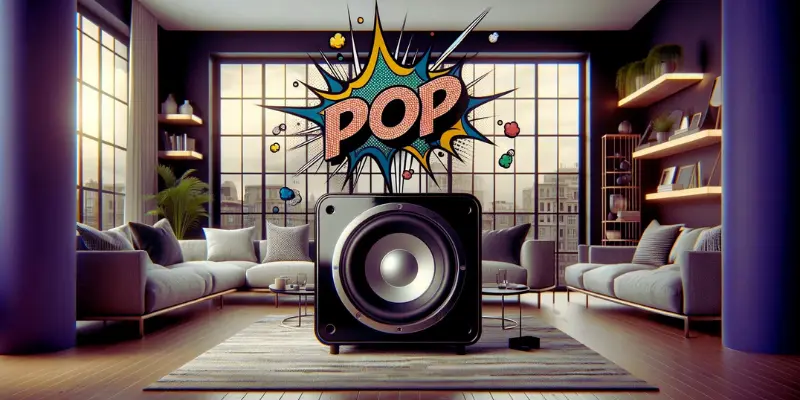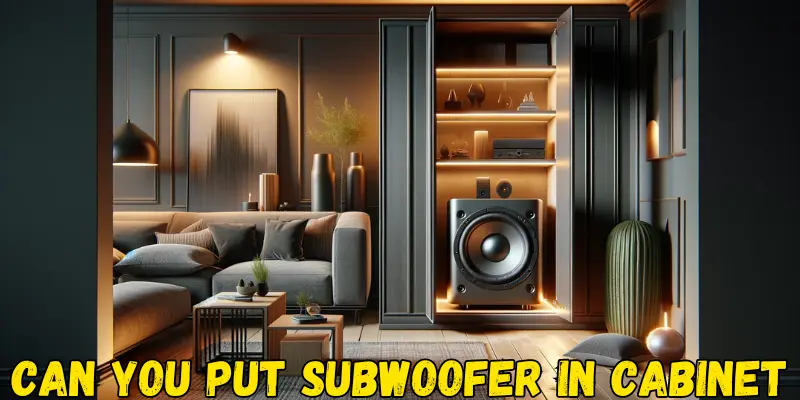
A subwoofer is a loudspeaker designed to reproduce low-pitched audio frequencies, also known as bass. It’s an essential part of any home theater or music listening system, as it provides the deep, rich bass often missing from speakers that only reproduce mid and high frequencies.
Subwoofers can last up to 20 years with proper care and maintenance. However, the lifespan of a subwoofer can vary depending on the quality of the subwoofer, how often it is used, and how it is cared for.
In this post, I’ll guide you on how long do subwoofers last, what are the main reasons why subwoofers damaged, and how you can make subwoofers last longer. If you want to know the answers to these questions, read this article from start to end.
If your subwoofer is giving out distorted sound then don’t worry I have uploaded a complete article on it you can read it.
Read More: How to Fix Subwoofer Distortion
Key Takeaways
- Subwoofers enhance audio with deep bass and can last up to 20 years with proper care.
- Lifespan depends on build quality, usage, maintenance, and environment. Reputable brands offer better durability.
- Balanced usage patterns, regular maintenance, and proper installation increase subwoofer lifespan.
- Overpowering and poor materials contribute to deterioration. Environmental conditions and neglect also impact longevity.
- Technological advancements improve subwoofer durability. Newer models feature enhanced cooling, protection circuits, and better materials.
- Power matching, controlled volume, proper installation, and maintenance prolong subwoofer life.
- Protect subwoofers from extreme temperatures, moisture, and sunlight for extended lifespan.
- Breaks between usage sessions and professional servicing can extend subwoofer life.
- Prevention of overpowering, proper setup, and maintenance routines contribute to subwoofer longevity.
- Maintaining balance in usage patterns, upkeep, and care preserves subwoofer performance and lifespan.
How long do subwoofers last?

Several factors come into play when it comes to the longevity of subwoofers. As a crucial component of audio systems, subwoofers often raise questions about their lifespan and durability.
In this answer, we’ll delve into the various aspects of determining how long subwoofers typically last and provide insights into maximizing their lifespan.
Understanding Subwoofer Lifespan
Subwoofers, like any electronic device, have a finite lifespan. However, their durability largely depends on building quality, usage patterns, maintenance, and environmental conditions.
While it’s difficult to provide an exact timeframe for how long a subwoofer will last, we can consider the following factors influencing its longevity.
Build Quality and Brand Reputation
The build quality of a subwoofer significantly impacts its lifespan. Subwoofers from reputable brands often incorporate higher-quality components and craftsmanship, leading to a longer lifespan. When investing in a subwoofer, opt for well-known brands with a proven record of producing reliable audio equipment.
Usage Patterns
How frequently you use your subwoofer and the volume levels you typically operate are crucial in determining its lifespan. Continuous high-volume usage can lead to excessive heat buildup and strain on internal components, potentially reducing the subwoofer’s lifespan. Maintaining a balanced usage pattern and avoiding prolonged periods of high-volume playback is recommended.
Maintenance and Care
Proper maintenance can extend the life of your subwoofer. Keep the subwoofer and its surroundings clean from dust and debris, as these particles can infiltrate the speaker and affect its performance.
Regularly inspect the wiring and connections to ensure they are secure and free from damage. If your subwoofer has a removable grille, gently clean it to prevent dust accumulation.
Environmental Conditions
The environment in which the subwoofer is placed also matters. Exposure to extreme temperatures, humidity, and moisture can lead to premature wear and deterioration of components. Place your subwoofer in a well-ventilated area and avoid exposure to direct sunlight or excessive moisture.
If you want to hide the subwoofer in a place where it looks beautiful and does not harm its sound, you can hide it under the sofa, behind the curtain, in the window and in the ceiling.
Read More: How to Hide Subwoofer
Technological Advances
Advancements in technology can also influence the lifespan of subwoofers. Newer models may incorporate improved materials, cooling mechanisms, and protection circuits, contributing to enhanced durability. Staying updated with the latest models and features can provide insights into the longevity of subwoofers.
What Causes A Subwoofer To Have Deteriorated?
Over time, subwoofers can experience deterioration, impacting their performance and sound quality. Let’s explore the key factors contributing to a subwoofer’s deterioration and what you can do to mitigate these issues.
Overpowering and Excessive Stress
Overpowering, a phenomenon where the subwoofer is driven beyond its rated power capacity, is a primary cause of deterioration. This results in undue stress on vital components like the speaker cone and voice coil. The continuous strain on these parts can lead to distortion, reduced sound quality, and permanent damage.
Poor Quality Materials and Construction
Subwoofers constructed with subpar materials and craftsmanship are prone to quicker deterioration. Low-grade adhesives, flimsy cones, and shoddy enclosures can compromise structural integrity, impacting sound reproduction. Investing in subwoofers from reputable brands that use high-quality materials is essential to avoid premature deterioration.
Do you want to get a good subwoofer on a budget of 500, 200, or 1000 then don’t worry I have written articles on them in detail you can read these articles to check the best subwoofer for me which one.
Environmental Factors and Improper Placement
Unfavorable environmental conditions can hasten subwoofer deterioration. Exposure to extreme temperatures, humidity, and direct sunlight can weaken materials, causing them to become brittle and susceptible to cracking. Placing a subwoofer in a well-ventilated, controlled environment can mitigate these effects and extend its lifespan.
Neglecting Maintenance and Care
Regular maintenance is crucial to prevent deterioration. Dust and debris accumulation can obstruct airflow, leading to overheating and reduced performance.
Failing to clean the subwoofer’s components and connections can result in poor connectivity and hindered sound quality. Routine cleaning and visual inspections are essential to preserve optimal performance.
Continuous High-Volume Usage
Operating a subwoofer at high volumes strains its components and generates heat. Excessive heat buildup can degrade adhesives, weaken materials, and cause warping.
Balancing your audio system’s volume levels and avoiding prolonged high-volume usage can significantly reduce the risk of deterioration.
Wear and Tear of Moving Components
The constant movement of components, particularly the speaker cone and voice coil, generates friction and wear over time. This friction can lead to the deterioration of these moving parts, resulting in reduced sound quality and distortion. Keeping usage within recommended parameters and avoiding extreme conditions can help mitigate this wear and tear.
Ignoring Technological Advancements
Advancements in subwoofer technology continually improve durability. Newer models incorporate improved cooling mechanisms, advanced protection circuits, and optimized materials. Ignoring these advancements can lead to using outdated equipment that is more susceptible to deterioration.
Read More: Are subwoofer worth it
How Do You Make Subwoofers Last Longer?

Subwoofers, essential components of audio systems, can extend their lifespan through careful maintenance and strategic practices. To ensure your subwoofer delivers deep, resonant bass for years to come, consider the following strategies:
1. Optimal Power Matching
Matching your subwoofer’s power handling capabilities with the amplifier’s output prevents overpowering, reducing stress on internal components and preventing damage. Avoid pushing the subwoofer beyond its limits, leading to distortion and reduced lifespan.
2. Proper Installation and Setup
Properly installing and setting up your subwoofer is critical. Follow the manufacturer’s guidelines for phase adjustment, crossover settings, and placement. Correct installation minimizes strain on the subwoofer, preserving its performance and durability.
3. Controlled Volume Levels
Continuous high-volume playback can lead to overheating and component strain. Utilize volume levels that ensure clear sound without overburdening the subwoofer. Avoid sustained high-volume usage, particularly at levels that cause audible distortion.
4. Regular Maintenance Routine
Create a maintenance routine to keep your subwoofer in optimal condition:
5. Suitable Environmental Conditions
Protect your subwoofer from unfavorable environments:
6. Utilize Technological Advances
Stay updated with the latest subwoofer technology:
7. Balanced Usage Patterns
8. Professional Servicing
Read More: Can a Subwoofer break Glass
FAQs
Conclusion:
A question from the music and home theater enthusiast is how long do subwoofers last. You should ask this question because you are investing, and you should know how long your investment will last.
By the way, no one can tell the exact lifespan of a subwoofer; if you keep the subwoofer carefully, your subwoofer can last from about seven years to twenty years. Many factors come into consideration when caring for a subwoofer. Including
- Optimal Power Matching
- Proper Installation and Setup
- Controlled Volume Levels
- Regular Maintenance Routine
- Suitable Environmental Conditions
Images Credit: Canva







